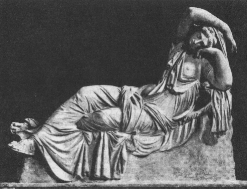 |
Minos was the founder of the Cretans sea lordship and the author of the Cretean constitution, with laws said to be suggested by Zeus himself.
Priest and lawmaker, Minos, because of his equity, had in the Hades the office of judge of the dead together with Rhadamanthus and Aeacus.
|
During the Ellenistic or the Greek-Roman age, we rather find Ariadne in her sleep (as in the well known statue in the Vatican Museum or in the Pompeian paintings) or, as the happy Dionysus' wife, in a procession of satyrs and Maenads. |
| The Minotaur is instead represented, in the Greek archaic art, as a creature with a bull head on a man body, standing or kneeling, in his fight with Theseus, or escaping; while, in the fifth century b.C., it appears the scene of its murder. |